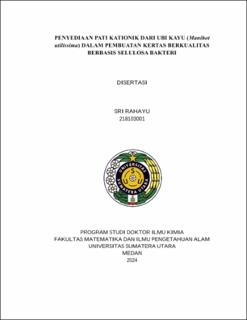| dc.description.abstract | Cationic starch (CS) is one of the most frequently used additives in the paper industry because it has a low substitution rate and is used as a dry reinforcing agent in paper surface coatings, and can improve the optical properties and strength of paper. In this study, the preparation of CS was carried out by the etherification method using 3-chloro-2- hydroxypropyl trimethylammonium chlorida (CHPTAC) and NaOH as a catalyst with a temperature variation of 50-90°C to produce a wet starch suspension. Furthermore, CS was dried using a spray dryer at a temperature of 200℃ produce CS powder. The results of FTIR and 1H NMR analysis showed that CS powder had been successfully prepared as evidenced by the appearance of C-N absorption band at wave number 1445 cm-1 from CHPTAC, has the same spectroscopic peak with commercial cationic starch (CCS) used as a comparison, has the highest degree of substitution (DS) value of 0.14, has a white colour, and has a crystallinity value of 15.12% and showing a more homogeneous granular morphology visible on the surface of the granules. Furthermore, the samples with the optimum temperature of 80℃ CS ware used as additieves in the manufacture of bacterial cellulose based paper (BC/CS). BC-based paper using unmodified cassava starch (BC/NCS) and bacterial cellulose based paper using commercial cationic starch (BC/CCS) as a comparison). The use of CS with variations of 0,9-4,5% in bacterial cellulose based paper showed that BC/CS has a smoother and more homogeneous surface structure, resulting in improved thermal stability, mechanical strength, and a stronger structure copared to BC/NCS paper as evidenced by the results of XRD, TGA and tensile strength analyses, so it has the potential to be applied as a filtration medium in industrial processes (such as liquid purification) or for laboratory use. The results of this study support the use of BC/CS in the sustainable and environmentally friendly production of paper. | en_US |


